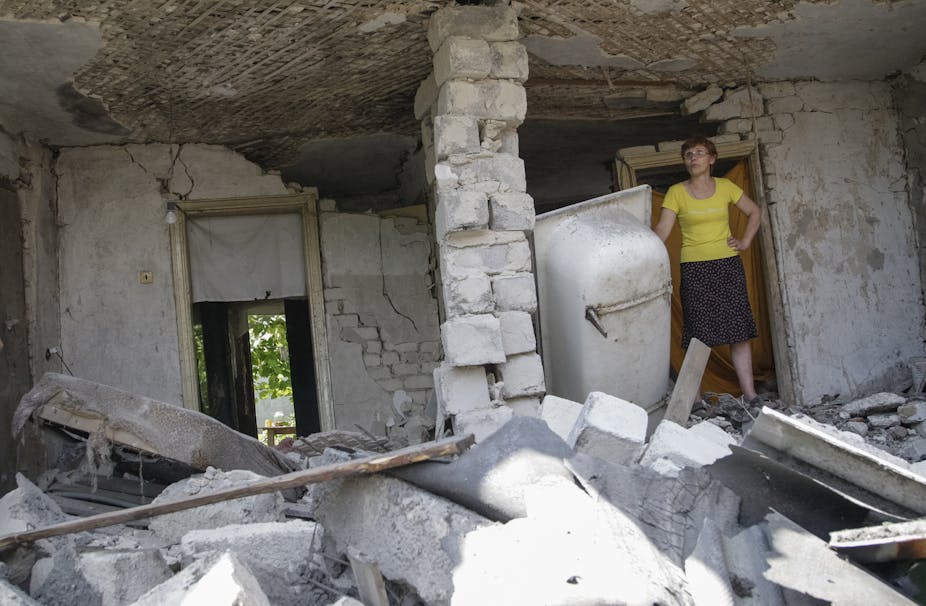While the rest of the world is preoccupied with terrorist attacks in Tunisia and Kuwait, the political crisis in Ukraine appears to be heading towards all-out war again.
There have recently been reports about troops gathering inside and outside Ukraine, and the ceasefire agreed in Minsk in February has been violated multiple times.
These are part of a longer trend that may soon pass a point of no return. Major hostilities between Ukraine, rebels in the so-called Donetsk and Luhansk People’s Republics, and Russia are on the horizon.
There is also a significant danger that the conflict will spread to involve the Transnistrian region of Moldova.
The escalation of tensions has been a steady process over several months, starting [almost immediately](https://theconversation.com/ukraine-ceasefire-announced-at-minsk-summit-what-next-37532 after the ceasefire was announced.
This has been compounded by continuing tensions beyond Ukraine. Russian violations of airspace, especially along NATO’s northern flank, and a massive NATO military exercise just 100 miles south of Russia’s Kaliningrad enclave, indicate how serious the crisis has become.
NATO has also decided to help Moldova build its defence capacity, while Canada is said to be considering allowing exports of weapons to Ukraine.
Kyiv gets tough
Developments in Ukraine have not helped the the situation either. The government has stepped up its economic and transport blockades on the “temporarily occupied territories of Donetsk and Luhansk” to include all goods – including food and medicine – and transport.
According to the newly appointed governor of Donetsk, the restrictions are in place to show people living in Donetsk and Luhansk that “their lives and wellbeing are possible in Ukraine only” – despite the fact that the Ukranian parliament adopted a declaration in May absolving itself of responsibility over the situation and stating that Russia is in charge of protecting human rights in these two areas.
At best, it is difficult to see how these decisions will help reintegrate Donetsk and Luhansk into Ukraine – as is foreseen in the second Minsk Agreement. At worst, one could interpret them as a deliberate attempt to undermine any future reintegration. They might even be seen as a way to exact additional punishment on a group of Ukrainian citizens who have already suffered severely as a consequence of a year-long civil war.
Not content with imposing blockades on Donetsk and Luhansk, Ukraine is now making similar moves against Transnistria. Ukraine has ended a deal that allowed Russian troops to pass through Ukraine to get to Transnistria, a strip of land to the west of Ukraine over which Russia and Moldova have long quarrelled, and which Moscow could potentially use to destabilise western Ukraine, and especially Odessa.
This effectively cuts off any way for goods from Russia to reach Transnistria via Ukraine – and is meant to turn Transnistria into leverage against Moscow.
The big gamble
Taking both of these moves together, the government has embarked on a huge geopolitical and economic gamble that is unlikely to end well.
It has put a stark choice to Russia: either formally annex the Donbas or withdraw support for the rebels. Ukraine may well prefer the former since reintegrating Donetsk and Luhansk under the terms of Minsk II would seriously undermine Ukrainian sovereignty and, to all intents and purposes, give Moscow a permanent veto on major Ukrainian decisions.
There is also a compelling economic rationale behind letting Russia take control of the areas. Ukraine can save significant funds by simply not paying any wages, salaries or pensions to people in the Donbas. This is a handy saving at a difficult financial time for the country. It can also hardly afford the kind of investment that would be necessary to rebuild either region.
What’s more, if Russia were to annex the currently rebel-held territories in eastern Ukraine, the country would get rid of both a disillusioned and at least partly hostile population.
Plan B, a Russian withdrawal, would be less convenient, but, in the longer term may present opportunities to regain Crimea: Ukraine would restore control over its border with Russia, face an opponent in Moscow weakened by continuing Western sanctions, and could more effectively pursue legal actions against Russia in international courts.
Dangerous miscalculation?
Yet neither of these two scenarios is likely to play out successfully. They are both predicated on a much more stable situation than presently exists or is likely to be achieved in the near future – and in any case, Russia has shown no intention of permanently annexing the Donbas.
In other words, public debate in Ukraine on the issue seriously misjudges both the value of the Donbas to Russia and the costs of simply maintaining the current status quo, however volatile it may be.
The rebels are well-armed, basic public services are maintained, and the continuing exodus of refugees is not too large to be of concern to Moscow. The greatest benefit for Russia is the continuing instability in Ukraine.
This is where the real danger lies. The next phase of the as yet incomplete implementation of the Minsk Agreement requires elections to local councils. The two nations are already at loggerheads over who will be eligible to vote and be elected. Necessary constitutional changes are a long way off, as are economic reforms required by Ukraine’s donors and creditors. And with EU leaders currently occupied with other matters, Ukraine and Russia may well be heading into another bout of armed conflict.

